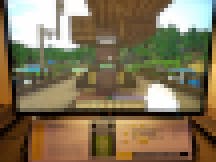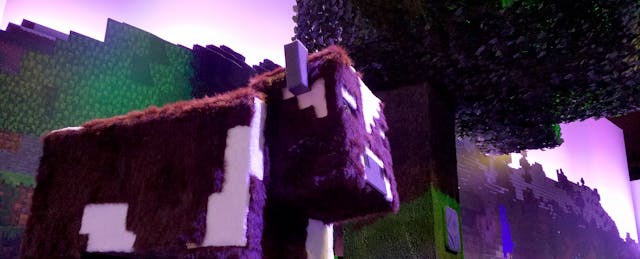A new museum exhibit celebrating Minecraft’s tenth anniversary doesn’t just highlight the block-building game’s role in education. The entire exhibition itself is, subtly, all about learning.
This month, the Museum of Pop Culture (MoPOP) in Seattle opened “Minecraft: The Exhibition.” Developed jointly by MoPOP and Minecraft creator Mojang, the world-premiere exhibit spans a decade of Minecraft’s growing popularity and influence, documented colorfully over more than 6,000 square feet of museum space.
A key emphasis of the exhibition is making the digital tangible. That begins at the entrance, where visitors face a roped-off gray cube slightly more than three feet tall.

“A block in the game is one meter on a side,” explained Brooks Peck, senior curator at MoPOP and co-curator of the exhibition. “So we wanted to show people what that’s really like, especially an American audience that doesn’t deal with meters very often.”
That visual understanding of size may surprise some visitors, since everything in Minecraft is somehow tied to a block.
“In the game you are literally picking these things up and moving them around and you’re putting them in your pocket and stuff,” Peck said. “A stone one-meter block, I calculated, is going to be around 1,200 pounds. I mean, it’s massive.”
Inside the exhibit, Minecraft is brought into the real world in several ways. There are 15 life-size Minecraft “mobs” (for “mobile non-player characters”) from a cow to a Zombie Pigman. A 3x3 crafting table sits at waist height, using RFID-chipped tiles and a “looking glass” 3D screen so visitors can make things from natural resources, with 33 possible combinations. Minecraft in-game scenes and environments are replicated with lighting and audio, such as The Nether underworld.

Stats are prominent on an official timeline. In May of this year, Minecraft became the best-selling game of all time, surpassing Tetris, and the number of Minecraft videos on YouTube exceeded five million. By September, Minecraft was logging 112 million average monthly users.
While the Survival and Creative gameplay modes are well represented, Minecraft in education is not an afterthought. Minecraft: Education Edition gets a place of honor on the exhibition’s timeline in November 2016, though it’s the Microsoft-sanctioned version and not the earlier MinecraftEdu modification, or mod, from TeacherGaming. Microsoft acquired first Mojang and later the mod before releasing its Minecraft: Education Edition.
More significant: there’s an entire room of the exhibition dedicated to the Education Edition overseen by a blocky Librarian villager mob. Three computer stations give MoPOP guests the opportunity to try activities related to chemistry (Element Scavenger Hunt), coding (Code Builder) and culture (Ngā Motu).

“I wanted to show the range of possibility because truly any subject can be taught with Minecraft,” Peck said of the three activities. “You can actually learn about Maori culture and learn Maori language just playing this Minecraft challenge.”
It’s the Maori module that “pushes the boundaries,” noted Peck, “and shows how much more Minecraft can do. You can hear dialogue, you get this sort of in-game notebook where you're gathering vocabulary.”
But even the apparently straightforward STEM activities such as chemistry are complex, under the hood.
“You can literally split water into hydrogen and oxygen and make latex and fill a balloon and it will go aloft. And then, because it’s Minecraft, you can tie a leash to the balloon, and tie a leash to a cow, and the cow will get lifted off the ground and float away,” Peck said.

Less overt educational activities are also part of the exhibition. Adjacent to displays and videos about Minecraft merchandise and the game’s place in popular culture is a section devoted to how Minecraft has been used as a tool for real-world change. The United Nations-backed Block by Block initiative, for example, spurred high school and college students in Manilla to create designs to revitalize a park, and school girls in Hanoi to craft improvements to the streets surrounding their schools.
Then there are the parents for whom the exhibit may be Minecraft 101.
“I’ve met a lot of parents who say to me, ‘My kid plays Minecraft. I don’t really know what they’re doing.’ A big, big goal of this exhibition is to speak to that audience,” Peck said. He’s pleased by adults who later say they get it.
“I’m loading the dice, right? What I’m pushing toward those adults is the educational capabilities of this game,” Peck said. “How it is a creative medium where kids can make whatever they imagine.”
Those capabilities, beyond focused classroom instruction, include everything from exploring a detailed three-dimensional model of the Titanic to helping rebuild the city of London after the great fire of 1666.
Peck observed that key to Minecraft is that it’s a place where kids can be inspired. “Minecraft is this intentionally simple, comical almost, simulation of our world where you can safely try things and fail. You can fail so much.” That, in itself, has value. “Everybody who gets into Minecraft, it’s basically constant failure,” Peck said, “as you’re learning how it all works and how to do it.”
Minecraft: The Exhibition is on view at MoPOP in Seattle, WA through September 7, 2020.


